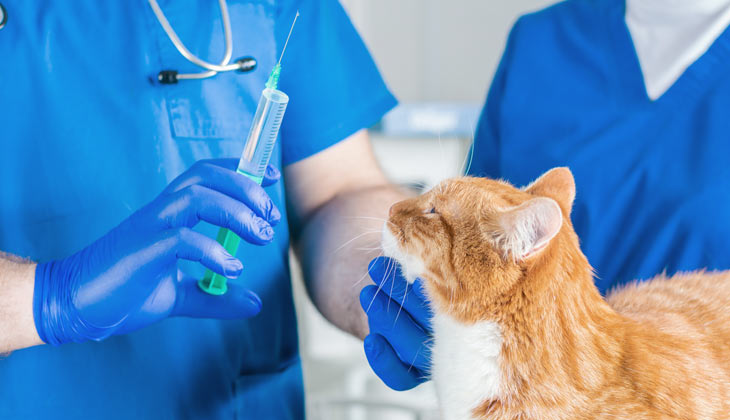Did you know that rabies was first described almost 5,000 years ago by the ancient Mesopotamians? It was also well documented in Europe for centuries, and around the 1700s, rabies was introduced to the United States and rapidly spread throughout the continent, establishing itself in native wildlife species.
Although rabies is established in many countries throughout the world, there are still many misconceptions and mischaracterizations about the infection, from cartoonish images of dogs foaming excessively at the mouth, to monster-like cats on the attack. And while some of these caricatures are based on reality, it’s a good idea to familiarize yourself with the real facts about this deadly disease.

A Lethal Virus
Rabies is caused by a viral infection of the nervous system which causes progressive inflammation of the brain and spinal cord. The disease can affect any mammal and once clinical signs appear, rabies is always fatal.
Rabies is found throughout the world, although a few countries have been declared “rabies-free” thanks to successful vaccination programs. North America and Europe have almost entirely eliminated rabies in domestic dogs, although in some areas it still affects wildlife, especially foxes, raccoons, skunks, and bats.
Rabies is still a major concern in South Africa with rabies cases being reported every year in pets and humans.
Rabies is almost always transmitted through the bite of an infected animal when saliva containing the rabies virus is transmitted into the body. The virus can be in the body for weeks or even months before signs actually develop.
Overall, most cases in dogs develop within 21 to 80 days after exposure, but the incubation period may be considerably shorter or even longer.
Signs and Diagnosis
The signs of rabies have historically been divided into two major types:
- Excitatory (“furious rabies”)
- Paralytic (“dumb rabies”)
However, individual signs can vary significantly from dog to dog, cat to cat, and species to species, and not all animals with rabies progress through each stage. Despite these differences, there are common signs most cats and dogs with rabies display.
The early stage of rabies infection (often called the “prodromal” or “initial phase”) includes the following signs:
- Nervousness, anxiety, restlessness
- Fever (more common in cats)
- Licking, chewing, clawing at the site of infection
These initial signs last from two to three days in dogs, and from one to two days in cats. The disease then progresses to either the furious or paralytic phase. Approximately two-thirds of infected dogs and cats will exhibit a furious phase, lasting from one to seven days. Cats more consistently develop this furious phase of the disease than dogs.
Clinical signs of the furious form of rabies are:
- Restlessness, aggression
- Increased sensitivity to sound and light
- Ingestion of unusual objects (dogs)
- Muscular incoordination, disorientation, and seizures
- Death
Some dogs will move from this phase to a paralytic phase, and others will only show a paralytic form of the disease. Cats frequently show both forms of the disease.
Clinical signs of the paralytic form of rabies are:
- Increased salivation or frothing at the mouth due to difficulty swallowing
- Difficulty breathing
- Choking sounds
- Voice change
- Coma and death

Very few animals survive the infection once clinical signs are noted. Almost all animals with rabies will die within 10 days of showing clinical signs. Humane euthanasia is recommended in dogs and cats when rabies is strongly suspected.
Clinical diagnosis of rabies is difficult, especially in areas where rabies is not common. The early stages of rabies can be easily confused with other diseases or with other aggressive tendencies. Attempts to make a diagnosis of rabies before death are not recommended and therefore, the animal must be euthanized and the disease confirmed post mortem through laboratory analysis.

Rabies is a Preventable Disease
Vaccinating your pet against rabies remains the best way to protect your pets as well as human family members from the disease.
Rabies vaccination has dramatically decreased the incidence and diagnosis of rabies in many
countries. The duration of immunity following vaccination against rabies, meaning the amount of time an animal is protected from disease after vaccination, is for many vaccines, at least three years.
But, due to the incidence of the disease, some South African provinces may require more frequent vaccination of pets; for example, in Kwa-Zulu Natal it is very common for pets to be vaccinated every year.
The World Health Organization (WHO) has strict guidelines in place to control rabies in the dog population. These guidelines include:
- Notification of suspected cases, with euthanasia of pets with clinical signs and those bitten by suspected rabid animals
- Leash laws and quarantine to reduce contact between susceptible dogs
- A mass immunization program with continued boosters
- Stray dog control and euthanasia of unvaccinated dogs that roam freely
- Dog registration programs
In areas where rabies is known to exist in the wildlife population (including bats), an animal that
is bitten or exposed to a wild, carnivorous mammal or bat should be regarded as having potentially been exposed to rabies.
Risk of Passing Rabies to People
Rabies remains a major concern worldwide, killing an estimated 59,000 people every year (WHO). Almost all of these deaths are due to rabies being transmitted by dogs in countries where dog vaccination programs are not sufficiently developed to stop the spread of the virus.
Bites from infected dogs are responsible for 99 % of human rabies deaths.
Pre-exposure vaccination is strongly recommended for all people in high-risk groups, such as veterinary staff, animal control officers, rabies and diagnostic laboratory workers, and travelers working in countries where canine rabies is common. However, pre-exposure vaccination alone cannot be relied upon. For healthy, unvaccinated people bitten by a rabid animal, treatment consists of wound care, local injection of rabies antibodies into the wound in some cases, and several doses of vaccine over a two-week period (so-called post-exposure prophylaxis, or PEP). When provided in a timely and appropriate manner, modern post- exposure treatment is highly effective.
It is important to remember that millions of people and animals globally have been vaccinated against rabies. It is estimated that vaccination saves more than 250,000 lives per year and today, the rabies vaccine is on the World Health Organization’s “List of Essential Medicines” as one of the most effective and safe medicines needed in a health system. If you have more questions for yourself or your furry companion, please consult your physician or veterinarian.
Looking for a Vet?
Your veterinarian plays a big role in your pet’s health. Input your location information and get a list of veterinarians near you.
Find A Vet Near Me





 Go To United States
Go To United States Austria
Austria Belgium
Belgium Czech Republic
Czech Republic Denmark
Denmark Europe
Europe Finland
Finland France
France Germany
Germany Greece
Greece Hungary
Hungary Ireland
Ireland Israel
Israel Italy
Italy Netherlands
Netherlands Norway
Norway Poland
Poland Portugal
Portugal Romania
Romania Slovakia
Slovakia Spain
Spain Sweden
Sweden Turkey
Turkey United Kingdom
United Kingdom